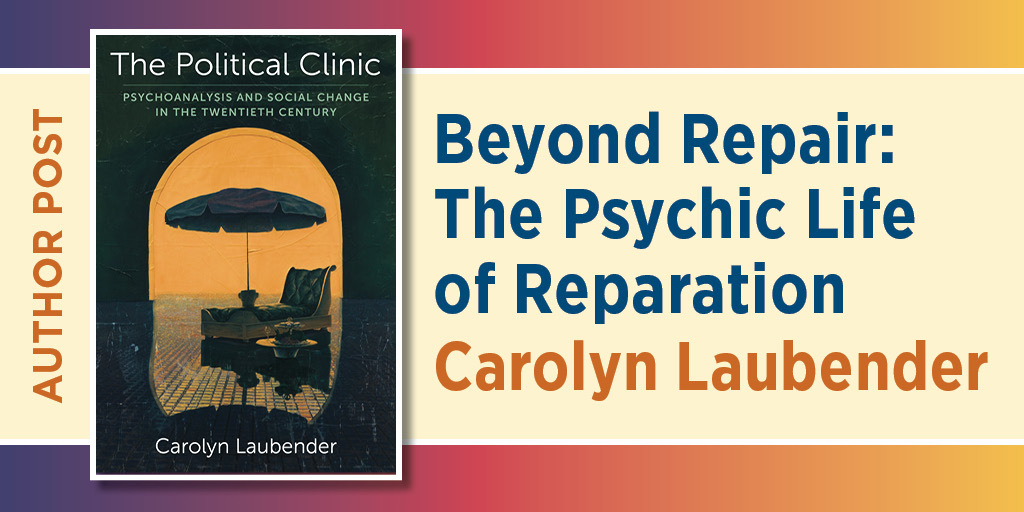Beyond Repair:
The Psychic Life of Reparation
Carolyn Laubender

Ten years ago, on June 15, 2014, Ta-Nishi Coates published his watershed Atlantic article, “The Case for Reparations.” An immediate cultural flashpoint, Coates’s piece sought to legitimize the demand for racial reparation in the contemporary United States by documenting how post-emancipation policy and legislation (such as the National Housing Act of 1934 and the G.I. Bill) were strategically used to exclude and extort working-class Black Americans, barring them from the upward mobility promised to their mid-twentieth-century white peers. Such legislation was, of course, not new. It simply built on the well-established antebellum theft of enslaved persons’ productive and reproductive labor power, without which the U.S. (colonial) nation-state could not have been founded. But Coates’s article added fresh evidence and energy to this point, broadening the issue’s audience. In the decade since its publication, “reparation” has continued to be a key term in U.S. public debates on racial injustice.
For many, Coates’s advocacy for a specifically fiscal remuneration will be the most familiar—and perhaps the only—known use of the term. It echoes a long-established history of interstate war reparations, wherein exchange is purely financial and the beneficiaries are states themselves.
But this cold economic calculus captures only one side of the complex way that twentieth-century reparations claims have been imagined and instituted. Taking Coates’s examination of U.S. chattel slavery as an example—though we could also easily consider reparations paid to Jewish survivors of the Holocaust, to Japanese-American survivors of internment, or to African-American survivors and heirs of the Tuskegee Experiment—most contemporary frameworks for reparations have expanded from being a principally state-based fiscal negotiation to being a transnational victim- and citizen-focused schema for arbitrating justice. Here, reparations attempt to identify injury and redress harm specifically by recognizing victims as victims through their status as rights-bearing national (or world) citizens. Thought historically, this is a vision of justice only conceivable because of the postwar global consolidation of nation-states and the affirmation of distinctly human rights through nongovernmental bodies like the United Nations, which newly prioritized persons over states. In other words, what defines contemporary reparations as a unique program for (global) justice is the victim-focused nature of its pursuit.
It was in this historical crucible that Melanie Klein, one of the most innovative and influential post-Freudian psychoanalysts, proposed yet another interpretation of the concept: reparation as a crucial psychological process. Her work throughout the 1930s, 1940s, and 1950s—that is, during the exact decades when public debates about reparation and justice first gained ground—transformed previously political conceptualizations of reparation into a unique framework for interpersonal psychic restitution. Through Klein, reparation became a critical concept in psychoanalytic, as much as political, theory.
It echoes a long-established history of interstate war reparations, wherein exchange is purely financial and the beneficiaries are states themselves.
For those not versed in the insider lore of psychoanalytic theory, Melanie Klein was born in Vienna in 1882 to Jewish parents, and she spent the first forty years of her life moving throughout Central Europe before finally settling in London in 1926, where she established her career. She was a pioneer of early child analysis, a leading voice in the British Psychoanalytical Society (BPS), and the founder of Object Relations psychoanalysis, which still dominates the British psychoanalytic scene today. Her influence reaches from the clinic to the university, with phrases like “bad object,” “phantasy,” and “projective identification” owing a direct debt to her.
Yet she is perhaps best known for her description of the mind as an oscillation between two different psychic positions, which she termed “paranoid-schizoid” and “depressive.” According to Klein, while the paranoid-schizoid position is characterized by anxiety, aggression, splitting, and projection, the depressive position is marked by love, guilt, ambivalence, and reparation. Reparation, for Klein, names our internal attempts to redress harm and “make good” on past phantasized destruction. It is one of the key processes associated with the depressive position and represents the culmination of the human being’s capacity for ethical relationality.
Throughout her work, Klein paints an appealing picture of reparation. In her thinking, reparation promises a form of collaborative sociality characterized by experiences of mutuality and recognition where the destruction and negativity central to early psychic life can be undone. She regularly associates it with terms like “love,” “hope,” “trust,” “sympathy,” “harmony,” and “goodness.” In so doing, she transforms what had been a primarily capitalistic and state-based articulation of political indemnity into a deep interpersonal accounting of injury and recognition. Reparation for Klein (and for many critical theorists influenced by her thinking, from political theorist C. Fred Alford to queer theorist Eve Kosofsky Sedgwick) serves as the aspirational horizon of ethical relationality. By elaborating the subjective and interpersonal side of reparation, her thinking provides the affective nuance that political economic schemas typically leave off.
Throughout her work, Klein paints an appealing picture of reparation.
However, as I discuss in much greater detail in the second chapter of my book, The Political Clinic, Klein’s idealization of the psychic life of reparation is significantly more complex than she (and many of her later interpreters) would have us think. Throughout her career, Klein insistently disavowed any relation to politics, clinical or otherwise. Despite her adoption of reparation as a key psychological and ethical process, she never mentioned the political side of reparation, nor did she consider the political status of the objects both taken up and cast aside in our various reparative addresses. For Klein, the internal process of intending reparation was what mattered most.
The consequences of this elision are substantial. For one thing, it meant that when Klein offered social examples to illustrate her metapsychological theories, she drew on some troubling comparisons. Take, for instance, the time she somewhat unbelievably cited settler-colonialism as a clear instance of “true reparation,” explaining that the aggressive decimation of indigenous peoples was eventually “restored” by colonists “repopulating the country with people of their own nationality.”[i] Or, consider the time she described as reparative a woman’s sudden desire to paint—only to offhandedly note the seemingly incidental fact that the image she painted was the body of a “naked negress.”[ii] In both cases, Klein showed a stubborn insensibility to the violence against racial minorities that these supposedly reparative gestures authorized.
More than mere historical anachronisms, these anecdotes illustrate a vital point about Klein’s abstraction of reparation from politics. Klein is only able to valorize psychological reparations because she exclusively focuses on the subject’s intention and strategically depoliticizes the status of the objects toward which the subject’s actions are geared. In this way, she separates reparation from its affiliation with justice and values it only as an ostensibly abstract psychological orientation, a move that extends psychoanalysis’s troubling and politically conservative tendency to sever psychological norms and ideals from their social and historical contexts in the name of scientific neutrality and objectivity.
From this, my concluding question is a simple one: What picture of reparation do we get if we try to meld psychoanalysis’s fraught ethico-psychological thinking about it with the citizen-focused political demands for reparative justice today? Although clinical concepts like “splitting,” “projection,” and “reparation” are typically treated as universal psychic processes, I argue throughout The Political Clinic that (when thought politically) the different objects to which these concepts are applied necessarily transform their ethico-political value. Klein’s theory of reparation therefore provides us with an opportunity to reimagine clinical practice as a vitally political operation whose methods and content are not distorted but rather strengthened and finessed by an understanding of their political implications. Through reparation, we can begin to glimpse a political clinic for the future.
Carolyn Laubender is an associate professor in the Department of Psychosocial and Psychoanalytic Studies and the founding codirector of the MA in Gender and Sexuality Studies at the University of Essex. She is the author of The Political Clinic: Psychoanalysis and Social Change in the Twentieth Century.








